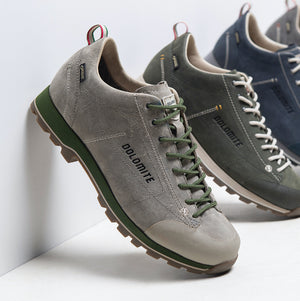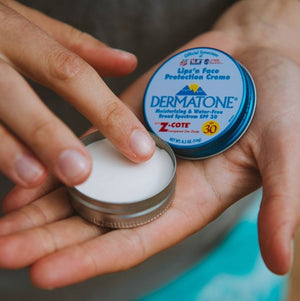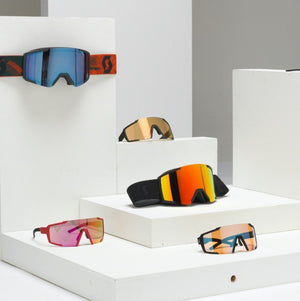HOW TO PICK THE BEST SUNSCREEN
There’s nothing like a dose of the New Zealand sun for your mental and physical health and with tons of stunning outdoor adventure destinations on offer there’s no keeping Kiwis indoors. But whilst we’re all seasoned professionals in lapping up the rays, it seems Kiwis are still frequently forgoing one key thing, SUNSCREEN. And it really shows. Year upon year New Zealand is still clocking some of the highest rates of melanoma in the world.
So, what can you do to protect you and your skin from becoming the next statistic? With hundreds of sunscreen brands on the shelf it can be overwhelming and confusing when trying to pick the “best” sunscreen. Especially when these days there is so much lingo and medical jargon to navigate… SPF, UVA, UVB, mineral vs sport, reef-safe, aerosols vs creams… the list goes on! Well, we’ve done the dirty work for you and compiled our crash-course to understanding and spotting the best sunscreens on the shelf. So read on and become an over-night sunscreen connoisseur…
THE BASICS
First of all sunscreen, suncream and sunblock are all just different names for the same thing – a product that protects your skin from harmful ultraviolet (UV) radiation emitted by the sun. Although UV rays aren’t visible to the human eye, they can inflict immense damage on the DNA in your skin cells and lead to skin cancer. There are two types of these harmful UV rays:
-
Ultraviolet B rays (UVB): cause sunburn and play a key role in developing skin cancer
-
Ultraviolet A rays (UVA): penetrate deeper into your skin than UVB rays to cause lasting skin damage that leads to advanced skin aging and wrinkles, whilst also contributing to sunburn
Together, UVA and UVB rays make a sinister team that can damage the skin to the point of skin cancer. So, it is essential that your sunscreen protects you from both. “Broad Spectrum” sunscreen formulations contain ingredients that provide proportional UVA and UVB protection, meaning that you can trust your skin will be receiving protection against the entire spectrum of harmful UV radiation. Put simply, a broad-spectrum certification is a must have on your next sunscreen’s label.
WHAT TO LOOK FOR
Look for sunscreen labels sporting the words “broad spectrum” to achieve the greatest protection against the spectrum of harmful UV rays.
SPF30 VS SPF50
The SPF (Sun Protection Factor) of a sunscreen is a measure of how well that sunscreen will protect your skin from sunburn. The SPF number tells you how long the sun’s UV radiation will take to sunburn your skin in comparison to how long it would take if you weren’t wearing sunscreen at all. So, for example, if you wear an SPF30 sunscreen, theoretically it would take your skin 30 times longer to burn than if you weren’t wearing any sunscreen.
As the SPF number increases the ability of the sunscreen to block UV rays increases. For instance, an SPF 30 allows approximately 3 percent of UV rays to hit your skin, whilst an SPF50 allows only around 2 percent of UV rays to hit your skin. You might think that this just a small difference, however this means that the SPF 30 is allowing 50 percent more UV radiation onto your skin than the SPF50. Therefore, the higher the SPF number in your sunscreen the greater protection you will achieve against sunburn.
WHAT TO LOOK FOR
Look for labels with higher SPF numbers to achieve greater protection. The New Zealand Dermatological Society (NZDSI) recommends at least SPF30.
CHEMICAL VS MINERAL SUNSCREEN
Sunscreens are divided into two main categories: chemical sunscreen and mineral sunscreen. Both are effective in blocking UV radiation but do so in different ways. Chemical sunscreens use chemicals that bond and absorb into your skin to filter UV rays. Mineral sunscreens (AKA physical sunscreens) contain natural minerals such as zinc oxide and titanium dioxide that sit on top of your skin and physically block UV rays.
Both chemical and mineral sunscreens have their pros and cons, and both are effective in blocking UV radiation (they just do so in different ways). So, when it comes to picking between the two just go with what is best for you and your skin by taking into account your skin type, lifestyle and future sun activities.
CHEMICAL SUNSCREENS
PROS
- Typically more water-resistant harder to wash off and longer lasting during water/sweating activities
- Absorbs quickly
- Lightweight and non-sticky
- Good for daily wear
- Give the same SPF protection as mineral sunscreens but with less product
CONS
- Difficult to see coverage/notice wash-off
- May contain chemicals that are harmful to marine environments
- Can be irritating to sensitive skin
- Requires regular reapplication
MINERAL SUNSCREENS
PROS
- Gentle on the skin
- Easy to see where sunscreen has been applied or where sunscreen has washed/rubbed off
- More photostable so doesn't have to be applied as regularly as chemical sunscreens
- Typically contain more eco-friendly ingredients
CONS
- Tend to be heavier on the skin
- Requires more product on the skin for the same SPF protection as chemical sunscreens
- Typically less water-resistant – easier to wash off and shorter lasting during water/sweating activities
WHAT TO LOOK FOR
Both chemical and mineral sunscreens are effective protectors against UV radiation. To choose the best option for you, weigh up their pros and cons against you and your skin’s personal needs.
WATER RESISTANT VS NON-WATER RESISTANT
There is no such thing as a waterproof or sweat proof sunscreen and there are rules against manufacturers claiming that they are. There are, however, water-resistant sunscreens. Water resistant sunscreens prevent the wash-off of active ingredients, meaning they provide greater protection whilst swimming or sweating compared with regular sunscreens.
The degree of a sunscreen’s water resistance can be identified on its label as a time limit of either 40 or 80 minutes. A 40-minute water resistant label indicates that the sunscreen is effective for a 40-minute window while swimming or sweating and should be reapplied thereafter. An 80-minute sunscreen offers even greater resistance, providing 80 minutes of protection when swimming or sweating.
Given that chemical sunscreens bond with and absorb into your skin whilst mineral sunscreens tend to just sit on top, chemical sunscreens typically offer greater water-resistance. Remember though, water-resistant or not, no matter what sunscreen you’re wearing, it is always good practice to reapply your sunscreen after swimming or sweating.
WHAT TO LOOK FOR
Planning on going swimming or participating in activities that are going to make you sweat? Select a water-resistant sunscreen to ensure protection during any activities. Look for chemical sunscreens as these typically have higher water-resistance than mineral sunscreens.
SPORT SUNSCREEN VS REGULAR SUNSCREEN
Sport sunscreens aren’t just for athletes or to be used exclusively during sport. In fact, they’re just your regular-joe chemical sunscreens but marketed with emphasis on high quality, long-lasting, broad-spectrum and high water resistant (80-minute) protection for any activity from pool parties, swimming and relaxing to hiking, outdoor adventuring and water skiing. Basically, sport sunscreens are an easy no-brainer option that you can snatch off the shelf in the chemist when you’re in a rush and know that you’ve got a high-quality sunscreen that will keep you protected during whatever activity you’re rushing off to.
But that’s not to say that regular chemical sunscreens or even mineral sunscreens are worse than sport sunscreens. Lots of sunscreens may have all the same key attributes you want in a sunscreen just without the sport label. It just means you might have to take the extra time to check the label to ensure broad-spectrum and high-water resistance protection.
WHAT TO LOOK FOR
Choose sport sunscreens to ensure high quality, long-lasting, broad-spectrum and highly water-resistant protection for any activities you’re planning (not just sports).
SPRAY SUNSCREEN VS CREAM SUNSCREEN
The ever-popular debate! Spray or cream sunscreen? Well, its looking like the creams have it. While spray sunscreens require a little less elbow grease and allow you get to those hard-to-reach places, it seems they aren’t the healthiest option for your body and for the environment. Although spray and cream sunscreens are essentially the same thing inside the bottle with the same level of protection, it’s the spraying that makes the difference.
First of all, the Cancer Society warns that it is much harder to achieve full protection with spray sunscreens given that it is difficult to dispense enough sunscreen for full body coverage. Spray sunscreen studies show that many people apply only one-quarter of the amount of spray sunscreen required for adequate protection.
Also, aside from being a fire hazard, the propellants used in some spray sunscreens may pose health risks if inhaled. Finally, spray sunscreens also pose a greater risk to the environment as a large proportion of droplets will not make it onto the skin and instead fall into the surrounding environment where they can seep into marine ecosystems.
Overall, spray sunscreen isn’t recommended but can provide just as excellent protection as cream sunscreens if used expertly and consciously. If spray sunscreen is all you have on hand, try spraying it directly into your hands and then rub it onto your skin to avoid the risks associated with the spraying.
WHAT TO LOOK FOR
Go for cream sunscreens over sprays. Though spray sunscreens might be more convenient, they are typically considered worse at protecting you and the environment.
PROTECTING YOUR SKIN AND THE ENVIRONMENT
Unfortunately, sunscreens are not as good at protecting the environment as they are our skin. Common sunscreen ingredients, especially those found in chemical sunscreens, are notoriously damaging to the environment. Common UV filters found in chemical sunscreens such as oxybenzone (AKA benzophenone-3 and BP-3) and octinoxate are especially harmful to coral reefs, to the point where island countries such as the Virgin Islands and Hawaii have outlawed the sale of sunscreens containing these chemicals entirely. Unfortunately though, for many other countries, the legalities surrounding labelling of sunscreens as “reef safe” are relatively underdeveloped, leading to a rather blasé use of the term by sunscreen manufacturers. That is, just because a sunscreen may claim that it is reef safe does not necessarily mean that it is. That’s where your consumer awareness comes in…
As a general rule of thumb, chemical sunscreens are more likely to not be reef safe (definitely not if they contain oxybenzone and/or octinoxate). Mineral sunscreens on the other hand typically contain much more ecofriendly natural minerals such as zinc oxide and titanium dioxide as their main active ingredients. However, these may also be accompanied by additional harmful ingredients or even mixed in with chemical filters such as oxybenzone so keep an eye out.
However, mineral sunscreens sometimes utilise zinc oxide and titanium dioxide in their nano-mineral forms rather than their micro-mineral forms. These tinier (nano) forms of the minerals can be harmful to marine life (and potentially even us) as they are more easily absorbed by organisms which can lead to toxic health effects.
Here is a quick check list of some of the top sunscreen ingredients you should avoid in order to pick a more eco-friendly sunscreen:
- Oxybenzone
- Octinoxate
- 4-methylbenzylidene camphor
- PABA
- Parabens
- Triclosan
- Any nanoparticles or “nano-sized” zinc or titanium
- Any form of microplastic, such as “exfoliating beads”
WHAT TO LOOK FOR
Mineral sunscreens are generally more eco-friendly than chemical sunscreens since they do not contain chemical UV filtering ingredients that are toxic to marine life.
Look for mineral sunscreens with labels specifying “non-nano” or “micro sized” ingredients and an active ingredient list than only includes zinc oxide and titanium dioxide.
Steer clear from chemical sunscreens containing environmentally damaging ingredients such as oxybenzone or octinoxate.
NOW THAT YOU’VE CHOSEN YOUR SUNSCREEN…
Now, just because you’ve managed to buy the best sunscreen on the shelf does not mean you are guaranteed complete sun safety. You have to know how to use it, otherwise all that new sunscreen knowledge is for nothing. In order to get the maximal protection from your sunscreen The Cancer Society recommends that you:
- Wear sunscreen every day that the UV index is forecast to be 3 or above (even when its cloudy)
- Apply sunscreen 20 minutes before going outdoors
- Apply approximately 5 mL (1 teaspoon) of sunscreen for each major section of your body (arm, leg, body front, body back and face – including neck and ears)
- Reapply sunscreen every 2 hours or after swimming, sport, sweating or towel drying
- Use sunscreen in combination with other sun protection measures including protective hats, clothing and sunglasses as well as seeking shade.
- Just remember the old classic Slip, Slop, Slap, and Wrap
Congratulations! You made it to the end of our crash-course and are now a certified sunscreen connoisseur. Next time you head to the store, put your new skills to the test and find the best sunscreen for you. Or even check out our own
Dermatone sunscreen range and see how we stack up! We promise you won’t be disappointed








Leave a comment